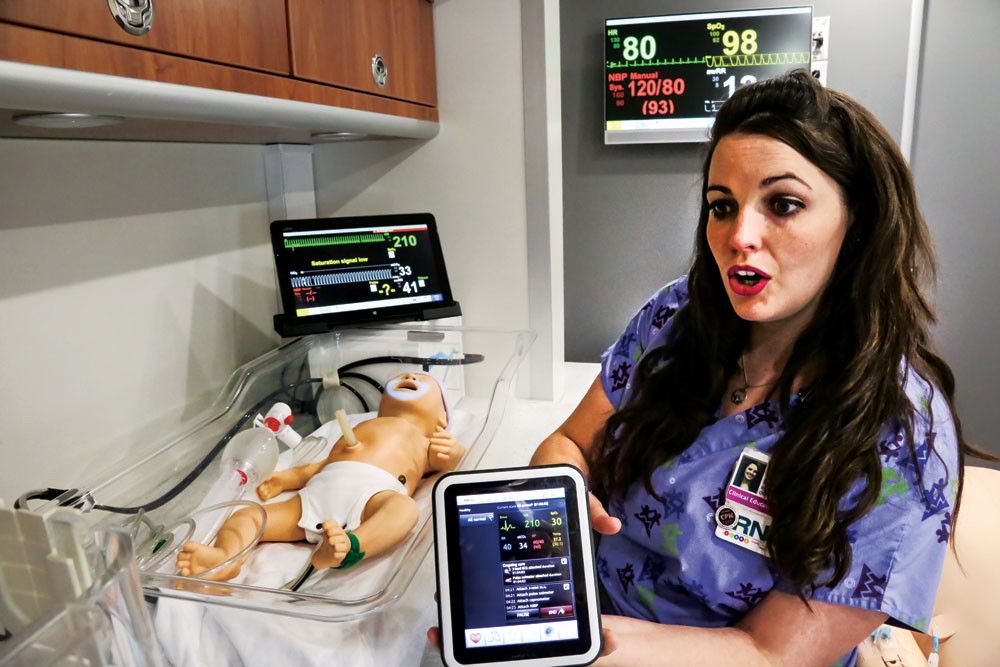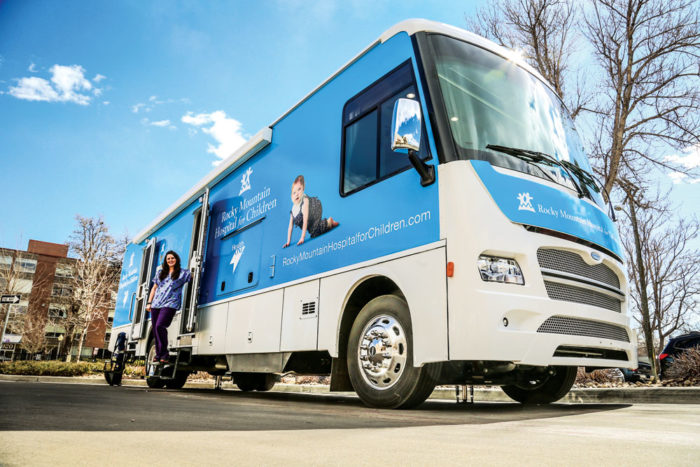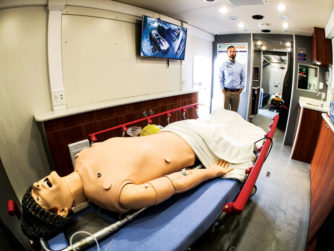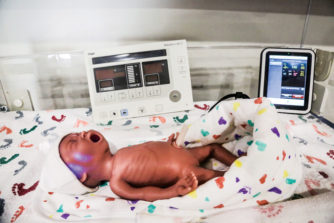
Rebecca Peterson, BSN, RN, CPN explains that Hope, a 1-month-old full body manikin, is monitored using the same technology as a human patient.
Many emergency responders do not have the opportunity to get advanced pediatric training. Now, a new mobile medical training unit is bringing hands-on pediatric training to healthcare providers in rural and urban settings.

Rocky Mountain Hospital for Children’s new Mobile Training Center offers specialized training in pediatric emergency care.
The Mobile Training Center carries four state-of-the-art manikins of different sizes to accurately simulate the needs of children ranging in age from premature infants to adolescents. The manikins can be programmed to move, talk, cry, and experience skin color changes. They also have visible respirations and audible heart and lung sounds. Healthcare providers use them to practice resuscitation, intubation, and intravenous line placement.

Paramedics Justin Thomason (left) and Brian Mikkelson (right) practice pediatric intubation and respiration procedures under the guidance of EMS Manager, Benjamin Dunn (center).
Northglenn Ambulance paramedics Justin Thomason and Brian Mikkelson say continuing pediatric education and training is especially important for first responders. “In our service area, we can go up to a calendar year without seeing a pediatric patient,” says Thomason. “When we do get a call involving a child, it typically involves trauma, respiratory difficulty, acute illness or an allergic response.” Acknowledging the importance of feeling fully prepared and comfortable when treating children, Thomason and Mikkelson say practicing their skills on the manikins gives them added knowledge, experience and confidence.

Ryan, an adolescent simulation manikin, can move and talk with visible respirations and audible heart and lung sounds.
The unit is equipped with Wi-Fi, video cameras, broadcasting capabilities, and TVs to provide clinical training for Emergency Medical Services (EMS) providers, inter-facility transport teams, hospital healthcare providers and school nurses. On board the Mobile Training Center, simulated ambulance and emergency room areas provide pediatric training in both settings. Manikins named Chloe, a 25-week premature infant, Hope, a 1-month-old newborn, Max, a 6-year-old, and Ryan, a 16-year-old, offer providers the opportunity to hone their critical thinking and assessment skills in a variety of medical emergency scenarios.
Simulation training helps “bridge the gap” for providers, says EMS Manager Benjamin Dunn. Often, he explains, first responders don’t know exactly what happens to a patient after arrival at the emergency room—and hospital personnel don’t always know exactly how a scenario unfolds in the field. “The training emphasizes patient care from the 911 call through tertiary hospital care, helping support the whole healthcare system,” Dunn says.

Hope, a 1-month-old manikin, exhibits color changes around her mouth indicating lower than normal oxygen intake.
The Mobile Training Center is the first of its kind in the U.S. to offer simulated ambulance and emergency rooms with state-of-the-art pediatric manikins. Owned and operated by Rocky Mountain Hospital for Children, the mobile facility can reach a broad range of healthcare providers and caregivers who wouldn’t otherwise have these training resources available. It made its debut two months ago and is now in high demand in both urban and rural areas. It will serve communities in a four-state region encompassing Colorado, Wyoming, Kansas and Nebraska.
In April, the Mobile Training Center will travel to Douglas County to provide instruction and education to 45 school nurses. Despite dwindling resources, school nurses face an increasing demand to administer student health care during the school day. Onsite mobile instruction and training offers a hands-on experience that might be otherwise unavailable.
The purpose of the Mobile Training Center is to “make healthcare education and training available to anybody,” says outreach education specialist, Rebecca Peterson, BSN, RN, CPN. Responsible for scheduling and traveling with the mobile unit, Peterson says partnerships with the American Heart Association and the Red Cross will help make it available for onsite cardiopulmonary resuscitation (CPR) training and certification for babysitters and caregivers. Citing the advantage of hands-on instruction, Peterson says, “Scenario-based training helps people retain 83 to 85 percent of what they learn.”

Chloe is the Mobile Training Center’s 25-week-old pediatric simulation manikin. She can be programmed to move and cry.
Chief Medical Officer, Dr. Reginald Washington says Rocky Mountain Hospital for Children is initiating a strong community outreach effort to make training available that would be difficult to get any other way. He says “demonstrated success and improved care” will be important outcomes of the mobile unit. A second Mobile Training Center may be on the road before long.
To learn more about the Mobile Training Center, call 720.754.1000 or visit RMHCOutreach.com.



0 Comments